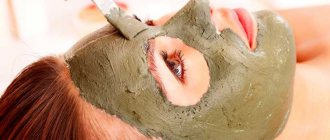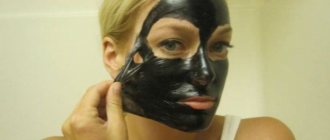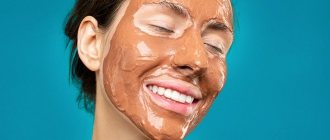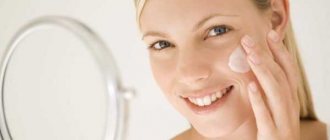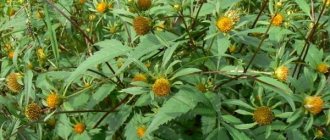Cosmetic clay as a cosmetic product has been known to the world for quite a long time. It is known to have antibacterial, anti-inflammatory and detox properties. In this article we will tell you about cosmetic clay: how to use, basic properties, composition, and so on.
On the shelves of ordinary stores it is very easy to find cosmetic clay of any color, either as a mono product or as one of the components in cosmetics. Depending on the color of the clay, its properties differ, but we will talk about this below.
Special composition of cosmetic clay
Despite the fact that the clay varies in color, the composition is practically the same. Here's what you can find:
- The most important substance is silicon oxide. It can restore injured blood vessels, improve collagen production and stimulate the regeneration process;
- Aluminum - dries out the skin (an excellent product for those with oily or combination skin types). Green, white and red clays contain the most of it;
- Manganese - it is thanks to it that clay works as an antiseptic;
- Magnesium - helps start the process of skin regeneration and rejuvenation;
- Copper - thanks to it, the production of keratin is stimulated, which is very important for rejuvenation and “glow”. It also protects the skin from the harmful effects of the environment;
- Zinc – protection against various harmful bacteria and cell rejuvenation;
- Other components - iron, phosphorus, nitrogen and others nourish the skin with important substances.
Rules for preparing white clay face masks
The rules for preparing masks at home are quite simple:
- Use only glass or ceramic dishes for cooking. A metal bowl will not work, because the minerals that make up the clay can react with the metal and lose their beneficial properties.
- It is best to dilute clay with boiled water. But not hot, but slightly warm. The consistency of the resulting substance should resemble sour cream.
- Before applying the mask, first cleanse your face. It is better to leave the area around the eyes untouched.
- Apply the mask immediately after preparing it. Later it will harden and the moisture will evaporate from it. This will make it unusable.
- Never do the procedure if your facial skin is very irritated. This can cause itching and severe inflammation.
- Do not use a white clay mask more than once or twice a week. After carrying out 10 such procedures, cosmetologists recommend taking a break for about a month. If desired, the course can be repeated later.
How to use cosmetic clay: let's talk about the properties
Clay has a lot of important advantages, unique and inimitable. Namely:
- Cleansing - it penetrates deep into the skin through the pores, removes excess sebum (sebum), impurities and dust;
- Regulation - the activity of the sebaceous glands decreases, the production of sebum is normalized;
- Moisturizing - the skin after clay masks is velvety, even and smooth. Important: you should not let the clay dry out on your face (lighten and harden), otherwise, instead of moisturizing and nourishing, it will draw all the moisture from the skin. There is a solution: either spray your face with tonic periodically, or apply a very thick layer);
- Calming effect - relieves inflammation, eliminates irritation. Provided that you are not allergic to the components of the composition;
- The most important thing is the absence of age and other restrictions. It doesn't matter what skin type you have or how old you are. From adolescence to old age, you can safely use cosmetic clay for the face and body.
Indications/conditions for use
Cosmetic clay is a universal component for creating masks. Depending on the type and additional ingredients, it can be used for any skin type, condition, and age.
Recommendations for use:
- problematic and oily skin;
- the presence of acne, pimples and other cosmetic problems;
- pronounced greasy shine;
- redness or irritation, increased sensitivity;
- consequences of tanning and prolonged exposure to the sun;
- the appearance of the first signs of withering and aging of the skin.
Regular use of clay masks for facial skin improves the natural color, normalizes metabolic processes and the secretion of subcutaneous sebum, and also eliminates pollution and toxins even in the deep layers of the epidermis.
Cosmetic clay: sorted by color
As described above, clay varies greatly in color, slightly in properties and composition. There are several colors: white, blue, yellow, green, red and black. Let's start in order:
- White clay or kaolin: whitening and smoothing out unevenness. The most easily accessible and famous. White cosmetic clay will help with almost all skin problems: acne, flaking, redness, inflammation, and so on. It is easy to find in many formulations of skin and body care cosmetics. After using white cosmetic clay, sebum production is reduced, excess oily shine is removed, acne dries out and facial wrinkles are smoothed out. Moreover, kaolin can be used as a scrub or peel if you want to gently and gently remove dead skin cells;
- Blue clay: healing and drying. No less popular than white and is considered top due to the presence of many vitamins, minerals and microelements. Especially cadmium and cobalt. It is recommended for those with oily and combination skin types to use blue cosmetic clay for the face - acne and blackheads disappear over time. The complexion is refreshed, the skin becomes smooth, clean and radiant. A big bonus is the stimulation of blood circulation, which helps fight cellulite, stretch marks and inflammation;
- Yellow clay: freshness and tone. It contains sodium and sulfur, so it is perfect for dull and “sad” skin of the face or body - it’s a good oxygen shock. The effect is cumulative, but the first results will be visible after just a few uses - the skin will brighten, glow, look healthy and rested. If you have areas on your body with rough or dead skin (elbows, heels), you can apply yellow clay to them to soften, moisturize and exfoliate. It is also an excellent remedy for regulating foot sweating and eliminating unpleasant odor. You can make foot masks to exfoliate the skin on the heels, remove the stratum corneum and unpleasant odor;
- Green clay: relaxation and calm. The composition includes copper and iron oxide - hence the color. These components help stimulate blood circulation, which leads to a pleasant glow on the skin and gradual rejuvenation. Green cosmetic is recommended for use if you have dermatitis or oily skin (in the first case, be sure to consult your doctor!). It's great to take baths with green clay before bed - very relaxing and calming;
- Red clay: warming and healing. It has this color due to a lot of copper, potassium and iron oxide. The skin is very well saturated with oxygen, blood circulation improves. As a result, the elasticity and firmness of the skin increases. Red clay warms up the skin, so it is good to use red cosmetic clay in the cold season to avoid chapping and dehydration. For dry, sensitive or dehydrated skin, red clay is a real gift. Redness, itching, peeling and dryness disappear in a short period of time if masks are used regularly;
- Black clay: cleansing and protection. In its composition you can find magnesium, manganese, quartz, iron and many, many other benefits. Many of them perfectly cleanse the skin and remove dirt and toxins from it. In addition to them, the use of black cosmetic clay helps smooth cellulite and reduce fat. In many salons and beauty parlors, it is used as an anti-cellulite agent for body wraps, massages and other manipulations to reduce centimeters in girth in various places. In addition to all of the above, subcutaneous and intracellular metabolic processes are accelerated. As a result, the skin is not only nourished and moisturized, but also protected from the harmful effects of the environment.
Recipes for the best homemade masks
When choosing components of the composition, you should take into account the condition of the skin and the body’s sensitivity to them. Below are 17 of the best remedies that are easy to prepare at home:
Classical
A traditional clay mask is used to actively cleanse the skin of impurities, remove impurities and toxins. Suitable for any skin type, recommended for those with increased oiliness and a tendency to acne. To enhance effectiveness, it is recommended to first peel using any method.
To prepare the mask, you need to mix 2 tbsp. l. black or blue clay, add the same amount of mineral water without gas and mix until a homogeneous viscous mass. Apply a thick layer to the face, neck and décolleté, remove after 15 minutes and apply moisturizer.
It is recommended to cool mineral water slightly to a temperature of 10-12°C before adding it to the mask.
With talc and glycerin
The product has a powerful drying and cleansing effect. Reduces oily shine and tightens pores. Used to combat acne and other unpleasant rashes without noticeable redness. With regular use, you can achieve a matte complexion and even out your natural shade. Suitable for any skin type.
Recipe: Mix 5 g of pharmaceutical glycerin and 20 g of green clay in powder form. Add 10 g of talc or baby powder, 1 tbsp. l. mineral water without gas. Mix thoroughly until a viscous mixture is obtained, apply to the face, avoiding the area around the mouth and eyes. Remove the product after 15 minutes using a cotton pad. You can find out about other masks with glycerin here.
With milk and glycerin
A nourishing face mask with a cleansing effect. Recommended for problematic skin types with high oil content. The product can be used for weekly use; before starting work, it is advisable to steam the epidermal cells.
The recipe is simple - you need to mix 1 tsp. green clay and 1 tbsp. l. milk with 3.2% fat content, add 1 tsp. talc (baby powder). Apply a thick layer of the mixture to your face, remove with a cotton pad after 15 minutes and wash thoroughly.
Make a mask with zinc oxide
The product has a drying and cleansing effect, most effectively for combating pimples and acne. After use, the skin becomes matte, oily shine is eliminated and the functioning of the sebaceous glands is normalized.
To prepare, mix 20 g of green clay, add 15 g of baby powder or oatmeal and 2 g of zinc oxide. To improve the viscosity, you can add a little mineral water or green tea. Distribute the composition onto a previously cleansed face in an even thin layer, remove with a cotton pad after 15-20 minutes.
Zinc oxide is a white, odorless powder. Widely used in traditional medicine recipes.
With magnesia and zinc oxide
An effective recipe for working with problem skin. With regular use, you can get rid of excess oil, acne and pimples. The product also relieves redness and has a whitening effect. It is also used to prevent various rashes. Suitable for any age, has no contraindications.
To prepare the mask, you need to mix 1 tsp. green clay and starch, add 0.5 tsp. zinc oxide and 2 tsp. magnesia, add a small amount of water until a homogeneous viscous mass is obtained. Using a brush, apply a thick layer to problem areas on the face, rinse with cool water after 15-20 minutes, and then use a moisturizer. You can learn about other starch masks in this material.
For dry skin
The product is suitable for moisturizing skin prone to dryness. Eliminates peeling and enhances the protective properties of cells. With weekly use, you can achieve matteness and relieve redness. The mask is not recommended for use at a young age.
To prepare, you need to mix 1 tsp. natural honey, add 1 tbsp. l. white clay, a few drops of melt or mineral water for thickness. Before starting work, you need to heat the composition in a water bath, and after cooling, apply it to problem areas. Rinse off with running water after 15 minutes, use a moisturizer.
For problematic
The product is suitable for deep cleansing, disinfection and drying of skin prone to oiliness and acne. The mask relieves irritation and redness; it is not recommended for extreme dryness or severe peeling.
Mask recipe: mix 3 tbsp. l. green clay, add 30 ml of alcohol, 2-3 drops of lemon juice. Mix thoroughly until a homogeneous viscous mass is obtained, apply to problem areas. Rinse off with plenty of water after 15 minutes and apply a moisturizer or gel.
The alcohol in the mask has a strong drying effect. The product is not recommended for use if the skin is extremely dry and flaky.
From blackheads
Suitable for combating acne, pimples and other unpleasant problems. The product should be used in a limited course; the procedure time should not be exceeded. The mask qualitatively cleanses pores, normalizes the production of subcutaneous sebum and reduces the risk of developing comedones.
To prepare, you need to mix 50 ml of water and 2 tbsp. l. blue clay, add a few drops of fresh lemon juice. Mix all components until a viscous composition is formed, apply only to problem areas of the face and neck. Rinse off after 10-15 minutes with plenty of cool water.
For normal skin
A homemade mask is used to regularly cleanse and nourish the skin. It has a soft and gentle effect; with regular use, the shade is evened out and small expression wrinkles are smoothed out. Suitable for any age and type of epidermis.
To prepare the composition, you need to mix 3 tsp. blue clay and 1.5 tsp. starch, 1 tsp. talc or oatmeal, add a little water to obtain a homogeneous creamy mass. Apply a thin layer to the face, rinse after 20 minutes.
Whitening
Suitable for evening out skin tone, combating severe redness and pigmentation. It is used only in a limited course lasting up to 1.5 months. Not recommended for sensitive and thin skin.
To prepare the mask, you need to mix 10 g of cosmetic clay (the color depends on the type and condition of the epidermis), 1 egg white and 2 pinches of table salt. Apply the product in a thin, uniform layer to problem areas, rinse with plenty of water after 10-15 minutes. After the procedure, you should apply a moisturizing gel or cream.
For acne
The mask is suitable for any skin type, effectively eliminates acne and prevents its subsequent reappearance. With regular use, it tightens pores, normalizes the functioning of the sebaceous glands and relieves inflammation. Does not cause allergies or side effects.
Recipe: mix 2 tbsp. l. green clay and 1 tbsp. l. bodyagi in powder form, add chilled mineral water until a homogeneous mixture is obtained. Apply the composition to problem areas of the face, rinse with running water after 25 minutes. You can find out about other badyagi masks in the article.
Bodyaga is a popular preparation based on seaweed. Typically used to eliminate swelling and combat bruises and abrasions.
Acne for oily skin
This homemade recipe is only suitable for oily skin types. The product relieves severe redness and inflammation, cleanses cells and effectively fights pimples, comedones and acne.
To prepare, mix 1 tbsp. l. blue clay and 1 tbsp. l. table salt and water until the consistency of a thick paste is achieved. Apply to problem areas of the face for 20 minutes, rinse with water and use moisturizer.
For any type
An effective anti-aging mask, with regular use you can achieve a lifting effect. The product saturates cells with useful microelements, nourishes and enhances metabolic processes and regeneration.
Mask recipe: 2 tbsp. l. Mix cosmetic clay with 3 tbsp. l. milk or low-fat cream, add 1 tsp. natural honey. Apply the composition in a thin layer on the face, rinse after 15 minutes with cool running water.
Correct Cleopatra mask
A well-known mask to eliminate signs of aging and skin aging. The product improves the contour of the face, softens and cleanses even the deep layers of the epidermis. Recommended for use only after 25-30 years.
To prepare, mix 2 tsp. white and the same amount of green clay, add 1 tsp. grape seed oil, achieve a soft consistency by adding mineral water. Apply a thin and even layer to the face, rinse with water without waiting for the composition to dry.
With cucumber juice
The product helps eliminate redness and inflammation, cleanses and brightens the skin. Suitable for regular use, the most effective product for working with problematic or oily epidermis.
The recipe is very simple - you need to mix 1 tbsp. l. cosmetic clay and 2 tbsp. l. cucumber juice, bring to a viscous consistency. Apply a thin layer to the face, neck and décolleté area. Rinse off with water or a slightly damp cotton pad after 15 minutes; after the procedure, it is advisable to wipe your face with an ice cube. You can find out about other cucumber masks by following the link.
Scrub mask
Suitable for home peeling; with regular use, the skin becomes soft and velvety to the touch. Even deep impurities are effectively removed, pores are narrowed and slightly dried.
To prepare, mix 2 tbsp. l. oatmeal and 1 tbsp. l. cosmetic clay, add 1 tbsp. l. whey and 1 egg yolk. Bring to a thick consistency, apply to the skin with massage movements and wash after 3-5 minutes. Read about other oatmeal face masks here.
It is recommended to use a facial scrub no more than once every 14 days. With constant use, the protective forces of cells are reduced and the functioning of the sebaceous glands is disrupted.
For irritated skin
Suitable for working with problematic or oily skin with severe redness and irritation. The product cleanses pores, fights pimples, acne and prevents their secondary appearance. Suitable for any age, but not recommended for chronic skin diseases (psoriasis, dermatitis or eczema).
Dilute 1 tbsp. l. white clay in 2 tbsp. l. tomato juice, mix the ingredients thoroughly. Apply a thick layer to problem areas for 15 minutes and then wash with cool water.
Cosmetic clay: how to use for face and body
Making a clay mask couldn't be easier! You just need to mix the clay with water and you're done. You can mix the powder with anything:
- Warm water;
- Mineral water;
- Milk or cream;
- Green or black tea;
- A decoction of herbs and so on.
It is better to use glassware or, in extreme cases, plastic. It is better to avoid metal clay, since clay loses many important and useful substances in it. The consistency should be like sour cream (20-25%), such a density is very convenient to apply to the skin - it does not flow or drip.
How to apply a mask correctly
Clay is a natural product that does not provoke allergic reactions, so there are practically no contraindications for use.
It should not be used only in the presence of open wounds and purulent inflammations on the skin. Before using the mask, you need to do a test for the presence of an allergic reaction to the components: apply a little product to the inner surface of the elbow and leave for 15 minutes.
The result of using the product will be negative if you ignore the following application rules:
- The composition should be applied only to previously cleansed skin.
- Clay is not applied to the skin around the eyelids.
- Products to which there is an individual intolerance, confirmed by an allergy test, are not used as components of the mask.
Cleaning the face before applying clay is carried out in several stages. First, wash with warm water and remove makeup using a lotion that does not contain alcohol.
Make a compress and steam your face to open the pores and allow the beneficial substances to penetrate deeper into the skin layers. Steam your face with either hot water or a decoction of medicinal plants. The best option for a decoction is chamomile.
To apply clay, use a cosmetic brush or fingertips. The second option is more convenient, but you must wash your hands before the procedure. The clay layer should be quite dense, so it will dry out more slowly.
Cosmetic clay: how to use
Despite the simplicity of “preparing” a clay mask, for maximum effectiveness it is better to follow a certain algorithm of actions:
- Cleanse the skin of cosmetic residues with foam or another similar product;
- Treat with scrub or peeling (only gently so as not to injure the skin);
- Even better is to steam the skin for about 15 minutes. The better the cleansing, the brighter the effect of the mask will be;
- Dilute the powder with the liquid to the consistency of sour cream;
- Stir thoroughly, there should be no lumps or air bubbles;
- Apply the mixture to the skin in an even layer;
- Leave for about 15 minutes, but do not let the clay dry out! Spray your face with tonic or plain warm water from time to time;
- After the time has passed, rinse off the mask with warm water and pat your face dry with a paper towel;
- Apply a light moisturizer to seal the result.
Now you know how to use cosmetic clay for your face and body. This is a great beauty product because it is easy to find, cheap and very effective. Several colors can be mixed with each other and they will retain their benefits! The effect is cumulative, make masks from cosmetic clay several times a week and the results will not be long in coming!
Mask exposure time
You should not keep a clay mask for a long time, because when it dries, it begins to tighten the epidermis.
How long you should keep a mask made of any clay on your face depends on the type of epidermis:
- if the skin is dry, then the composition should be on the face for no longer than 5 minutes;
- if the cover is normal or combined, then the optimal time is 10 minutes;
- if the epidermis is oily, then the desired time is 15–20 minutes.
Attention! To prevent the clay from turning into a tightening crust on the face, it should be periodically sprayed with water from a spray bottle.
Contraindications
Clay is a natural, environmentally friendly material; when using it, you will not experience allergic reactions. However, if you bought a ready-made clay mask or are experimenting with different ingredients at home, study the composition. Does it contain components that will cause you to be individually intolerant?
You should not make a mask if you have inflammation, irritation or purulent pimples on your face. Do not apply the mixture to the skin around the eyes. Due to the lack of sebaceous glands, the skin in this area is dry and sensitive, and clay dries well.
For dry skin, cosmetologists recommend leaving the area of the nasolabial folds untouched to avoid drying out and deepening wrinkles.
Clay has a moisturizing effect only until it dries. When it dries, on the contrary, it begins to dry out and tighten the pores. Therefore, for dry skin, it is recommended to either purchase emulsion-based clay masks, or add a few drops of oil to a mask you prepare yourself.
Which clay to choose for problem skin
Like any other procedure, doing clay face masks too often is not recommended. In this case, the properties of the powder should be taken into account:
- blue clay is ideal for oily skin;
- red helps improve skin elasticity for older women;
- white clay whitens the face, eliminating age spots;
- green will narrow pores and reduce oiliness;
- black will dry out acne and get rid of oily sheen;
- pink is recommended for dry skin.
Typically, clay powder is diluted with boiled water. But in some cases, you can use milk, herbal decoctions, and glycerin.
Important points about using and applying masks
Before applying the mask, you need to figure out what materials are suitable for working with clay. The clay does not lose its healing properties when in contact with a wooden spatula, designed specifically for easy and convenient application. Of course, not every home has one. Therefore, you can use a brush for masks with natural or artificial bristles . As a last resort, apply the mask with a cotton pad. If you have combination skin, then apply a thicker layer to the problem T-zone; the clay will draw out excess fat.
Dry skin on the cheeks will give up all the moisture with a thick layer, so apply a thin layer to this area.
To determine how long you need to keep the mask on, it is important to understand that the time of the procedure with clay directly depends on your skin type and the type of mask .
- For dry, thin skin, keep moisturizing masks for up to half an hour.
- And if the mask is for acne, blemishes, tightening or whitening, then keep it on for up to 15 minutes. We start with 5 minutes.
- Leave masks for oily and combination skin on for 30 minutes.
While the mask is on your face, it is better to lie down with it and relax, since clay masks are not the lightest . They weigh down the skin of the face and can stretch it when positioned vertically.



